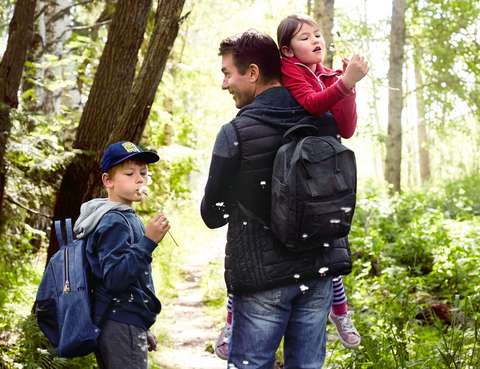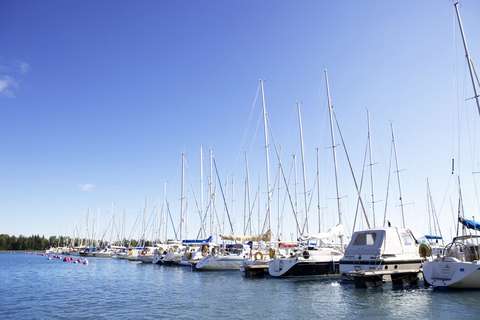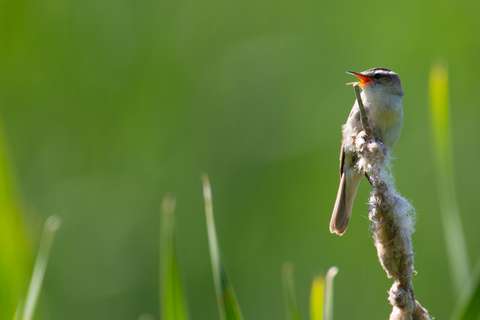Finnoo's nature
Finnoviken is a valuable and unique natural area in Finland. Its nature trails and bird-watching towers are popular recreational sites for all nature-lovers.
The Finnoviken wetland consists of a water basin and the surrounding flood meadow. The water basin was separated from the sea bay long ago through the building of an embankment. Nowadays, the shallow basin has reeds growing in it and open water surfaces, making it an ideal wetland for birds. The Finnoviken wetland is bordered by urban forests, and there are two streams flowing through the area: Finnobäcken and Djupsundsbäcken. The nutrient-rich soil and natural environment offer ideal conditions for plant life, various insects and birds.
The nature trails and bird-watching towers around Finnoviken attract both children and adults.

The natural values of Finnoviken have been recognised and are taken into account in the development of the area. An important bird habitat, the area was designated as a nature reserve in the new master plan and local detailed plan and protected with regulations when the City of Espoo chose Finnoo as one of its future metro centres and city districts to develop. A management and use plan has been prepared for the bird habitat, which will safeguard the area’s natural values as the surrounding urban structure continues to become denser.

Finnoo will be built close to the sea. The seashore provides many opportunities for services, hobbies and recreation. There will be shuttle boat links from the Finnoonsatama marina to the city’s several outdoor recreation islands.
The wetland is home to several threatened species, such as the Slavonian grebe, the gadwall and the northern shoveler, which are able to raise their young by the basin thanks to the black-headed gulls keeping predators at bay. The basin is also used as a nesting site by a sizeable population of common pochards, one of the fastest-declining waterfowl species in Finland. The second-most-common nesting bird in Finnoviken after the black-headed gull is the sedge warbler, which sings loudly among the reeds.

In addition to birds, the area is home to a variety of other rare animals and insects, including the Siberian flying squirrel, the moor frog, the northern bat, the Daubenton’s bat and the whiskered bat. The most notable insect species include the protected azure damselfly and Myrmica gallienii, an ant species that is exceedingly rare in Finland. Also found in the area are the beetle species Amara littorea, which is considered to be rare, and Phyllotreta exclamationis, which is classified as vulnerable.
In 2021, Espoo’s Public Works Department monitored birds in the Finnoviken wetlands in accordance with the management plan drawn up for the area. Based on the monitoring, the area had maintained its role as a valuable bird habitat. You can read more about the results in the report (in Finnish). The monitoring project was funded by the Helmi Habitats Programme of the Ministry of the Environment.
The Public Works Department also monitored birds in the wetlands in 2023. Based on the results, the area has still maintained its role as a valuable bird habitat. The number of breeding waterbirds has remained unchanged from 2021 to 2023, and there have not been changes in the species either. In the summer of 2023, there were eight endangered species. Among these species, only the black-headed gull population has declined in recent years.

The Public Works Department also monitored birds in the wetlands in 2024. Based on the results, the area has still maintained its role as a valuable bird habitat. The decline in the number of black-headed gulls ended in 2024, with an estimated 460 pairs counted from aerial photographs. Fourteen pairs of black-headed gulls nested on the city’s artificial nesting rafts.
Downloadable files
- Finnoon kosteikkoalueen linnuston seuranta 2021File is only available in Finnish
- Finnoon linnuston seuranta 2023.pdfFile is only available in Finnish
Downloadable files
Gull nesting rafts
The nesting of gulls in the Finnoviken wetlands will be supported by building two nesting rafts. The black-headed gull colony is also important for safeguarding the nesting of other bird species. The floating rafts offer more nesting places in the middle of the wetlands. The rafts will be located near places where black-headed gulls have had nests in recent years. It is important that the rafts are not disturbed or moved.
The City of Espoo has received funding from the Uusimaa ELY Centre under the Ministry of the Environment’s Helmi Habitats Programme for measures to restore the Finnoviken wetlands between 2022 and 2024. The nesting rafts are covered by the Helmi funding. The national Helmi programme aims to strengthen biodiversity in Finland and improve habitats, for example by protecting and restoring mires, restoring and managing aquatic bird habitats, semi-natural grasslands and forest habitats and restoring coastal and aquatic environments.
Intensified capturing of invasive predators
In 2023 and 2024, American minks and raccoon dogs were actively trapped in the Finnoviken wetlands and the surrounding area. A total of 43 raccoon dogs and seven minks were removed from the area.
The purpose of trapping is also to prevent new small invasive predators from entering the wetland area. Studies have shown that the capturing of minks and raccoon dogs has a positive impact on waterbirds and other native species.
In 2023 and 2024, the intensified capturing of small invasive predators was funded by the Helmi programme.
